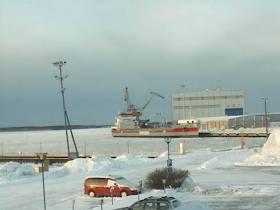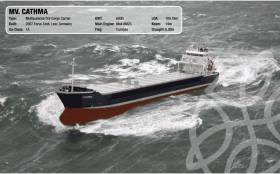Displaying items by tag: Corrib Shipping
Catch Up on MV Ziltborg: Corrib Shipping's Managed Cargoship Trading in Scandinavia & Beyond
Afloat returns to the Dundrum, Co. Dublin based Corrib Shipping which manages five cargoships for a Dutch operator, with the largest the MV Ziltborg which arrived in the Netherlands yesterday, writes Jehan Ashmore.
Of the five Corrib cargoships which has a total deadweight of 30,000 tons, the MV Ziltborg of 7,500dwcc is the largest of the Irish company that manages the fleet for the shipping company Royal Wagonborg based in Delfzijl.
The cargoships which feature Corrib's 'Celtic' motif on the funnel, form as part Wagonborg's fleet of 170 box-shaped multipupose ice-strenghthened vessels operating predominantly in the Baltic, northwest Europe, the Mediterranean, the Americas and the Far East.
The Ziltborg which was acquired 2017 as Afloat previously reported was built at the Dutch shipyard of Bodewes in Hoogezand to an Ice Class 1A to cope in harsh winter sea conditions. For example, when calling to the frozen Finnish port of Kokkola in the Gulf of Bothnia.
At the time in January, 2018 temperatures recorded at the port was -4° and were to drop further overnight to -6° (feeling more like -9°).
According to Corrib Shiping, usually the fleet when calling in Kokkola, load refined zinc slabs for Rostock in Germany and Amsterdam. Sometimes, the ships will load zinc concentrate (sourced from Bolidan Tara Mines) in Dublin Port and discharge in Kokkola and return with a load of refined slabs.
It is again from this port far north of the Baltic Sea that in late November this year, Afloat tracked MV Ziltborg depart Kokkola and head through the Baltic Sea to Norway from where the 118m cargoship went to anchor in Frierfjorden off the southern port of Porsgrunn.
Last Thursday, 1st December, a berth became available with the Ziltborg calling at the Herøya Terminal in Grenland Harbour, the port for Porsgrunn.
On this particular passage between Finland and Norway, according to Corrib Shipping there was approximately 6,300 tonnes of apatite on board. This was discharged from the ship's double skinned single-decker hold at the Herøya Terminal.
The mineral, apapite, which in appearance is pale green to purple, is primary used as a source of phosphate in the manufacture of fertilizer or used as calcium phosphate fluoride.
On Sunday, Ziltborg departed Porsgrunn and sailed light across the North Sea to arrive yesterday morning in Vlissingen, the Dutch port in Flushing.
The next cargo will be to load potassium and again is to sail into Scandinavian waters with a passage through the Baltic Sea and a return to the Finnish port of Kokkola.
Corrib Shipping added that Ziltborg may get another cargo of zinc slabs to load and so repeat the Kokkola-Rostock-Amsterdam run.
Dublin Based Ship Management Company's Ice-Class Cargoship At Anchor on Capital's Doorstep
A Dublin based ship management company's ice-strengthened multipurpose dry-cargo carrier was spotted at anchor in Dublin Bay today, writes Jehan Ashmore.
Such operators in Ireland are few and far between in regards to merchant shipping. The company concerned is the Corrib Shipping Group based in the south Co. Dublin suburb of Dundrum. The cargoship is due to enter Dublin Port on New Year's Day and berth at Ocean Pier.
Afloat also noted that the group was founded in 1995 and before this year finally draws to a close, such an occasion cannot be ignored given the company milestone of a 25th anniversary.
Since its inception Corrib has assembled a ship management team and employs professional officers and crew to man its vessels.Their fleet of ice-strenghthened ships sail as part of the Royal Wagenborg fleet and Wagenborg act as chartering agents for Corrib.
MV Jolyn had departed Cork Harbour yesterday and arrived in Dublin Bay this morning. The short-sea multipurpose dry cargo carrier has an Ice Class 1A and was built by the Shipyard Peters in Kampen in the Netherlands.
The 2007 built Dutch-flagged trader has a 3,640dwt and the following main dimensions where length overall (LOA) is 89.99m on a beam of of 12.5m and a draught drawing 5.31m.
As for propulsion the main engine is a Finnish manufactured Wartsila 9L20.
In addition Corrib's fleet includes a pair of identical ships, Cathy Jo and Cathma, again they too are of the same vessel type as applied to Jolyn along with an Ice Class 1A, but these vessels are larger. They are of 6,000dwt and measure 100.78 (LOA), a beam of 14m and a draught of 5.09m. Cathy Jo is currently in Palmones, Spain (close to Gibraltar) having departed Dordrecht from where relatively nearby in Amsterdam is Cathma which is for bound next for Hamina in Finland (see below the Ziltborg in a frozen Baltic).
Unlike the Jolyn, the pair were built in neighbouring Germany at the Ferus Smit shipyard in Leer, however their Dutch yard in Westerbroek is where 'A' class newbuilds, each of 8,500dwt is on order to Arklow Shipping. Less than a fortnight ago week, Afloat reported about Arklow Arrow, the fifth of six such ships so far was launched.
Another final member of the Corrib fleet, the former Viechtdiep in 2017 was added into a then four-strong fleet as the renamed Ziltborg, the largest fleetmember at 7,200dwt which too has an ice-class notation of 1A.
The owners of the 118 metre vessel are Royal Wagenborg which itself has a considerable fleet numbering 180 box-shaped ice-strenghtened vessels varying between 1,700 to 23,000 tonnes and all under the Dutch flag.
Ziltborg had entered service to offer clients worldwide trade carrying options such as forest products and (break-)bulk cargoes.
Another Corrib Cargoship Concentrates on Boliden Tara Mines Exports to Frozen Finnish Gulf Port
#Ports&Shipping - A Corrib Shipping cargoship loaded concentrates from Boliden Tara Mines facility in Dublin Port late last year, arrived at a Finnish port this first week of 2018 and where the sea is currently frozen over, writes Jehan Ashmore.
The cargoship Ziltborg which last year became the fifth ship of Corrib Shipping fleet, sails as part of Royal Wagenborg, a Dutch operator with more than 170 vessels. They also act as chartering agents for the Irish based ship management group located in Dundrum, Co. Dublin. The vessel previously named Viechtdiep was drydocked to emerge as the Dutch flagged Ziltborg and under the new livery of Wagenborg.
Trains transport the concentates to Dublin Port from Boliden's Co .Meath mine (Europe's largest for zinc) which since 1977 has extracted 85m tonnes of ore. At the port the concentrates are transferred from wagons to a conveyor belt that leads to a jetty within Alexandra Basin. At the bulk north jetty a loading shoot was lowered into the Ziltborg's cargohold.
On completion of loading the 7,200dwt Ziltborg's open hatch, full box and double skinned hull, the single decker cargoship departed Dublin on 28 December. It is at this facility where a fleetmate Cathma called in November and likewise of Ziltborg, involved a voyage to Kokkola. The western Finnish port town on the frozen icy Gulf of Bothnia, located in the Central Ostrobothnia region has a population of over 47,000.
The Gulf of Bothnia, that separates west Finland and east Sweden forms the northernmost arm of the Baltic Sea. The Gulf which is shallower in depth and being almost freshwater becomes frozen, as such traffic restrictions for icebreaker assistance are typically in force for all the gulf from later this month to the end of April.
The 118m Ziltborg which has an Ice Class 1A notation for operating in Finnish and Swedish waters, had arrived to Kokkola on Thursday of this week. As of today, weather conditions report temperatures of -4° and are to drop further overnight to -6° (feeling like -9°).
For a link to a livestream of the Ziltborg berthed in the frozen icy waters click here.
Corrib Shipping Group Add Fifth Cargoship As Part of Wagenborg Fleet
#FifthShip - Corrib Shipping, the Dublin based shipowners and ship management group has added a fifth cargoship to its fleet which is currently at a drydock in the Netherlands, writes Jehan Ashmore.
The new addition is a 7,200dwt cargoship recently renamed Ziltborg and which has an ice-class 1A notation and two-holds. Previously called Vechtdiep and under the Liberian flag, the 118 metre long vessel’s new Dutch owners are Royal Wagenborg who have reflagged the ship to the Netherlands.
Acquisition of Ziltborg last month will be a perfect fit for Wagenborg’s existing fleet of ice-strengthened multipurpose dry-cargo vessels. Ziltborg will offer worldwide trade carrying options such as forest products and (break-)bulk cargoes.
Ziltborg is expected to enter service under Wagenborg colours soon and join the existing Corrib managed fleet of four vessels. The Corrib ships sail as part of the Wagenborg fleet and they in turn act as chartering agents for the Irish based group.
Among the quartet of ships is Cathma which Afloat in August covered with a ‘snapshot’ of her trading work having discharged fertiliser in Foynes from Latvia.
Work on the Ziltborg is taking place in the floating dry-dock of the Royal Niestern Sander shipyard. The facility is located in the north-east of Netherlands with a direct connection to the North Sea via the port of Delfzijl.
The location is also the head office of Wagenborg which has a large fleet of around 170 vessels, mostly box-shaped ice-classed dry-cargoships with a capacity of 23,000dwt.
One of these fleetships, Keizersborg (1996/6,142grt) docked in Dun Laoghaire Harbour in 2013 loaded with Guinness fermentation tanks. The stainless steel cylinders, each weighing 30 tons were craned ashore at Carlisle Pier. Overnight truck conveys took the project cargo to St. James's Gate Brewery, where the plant in central Dublin was undergoing a major €153m upgrade.
The arrival of this large cargoship within the harbour was witnessed by crowds along the East Pier. Coverage of the unloading spectacle was also published in Ships Monthly, June 2013 issue.
#CargoshipFocus: Corrib Shipping, a Dublin based ship management company, whose Cathma, one of four cargsoships, is at anchor offshore of Cork Harbour this morning awaiting orders, writes Jehan Ashmore.
The 3,990 gross tonnage Cathma, flagged in Curacao a Dutch island in the Caribbean, had sailed light yesterday from Foynes Port. The cargoship having discharged a cargo of fertiliser from Ventspils, Latvia.
Cathma had taken almost a week to complete the voyage from the Baltic to the Shannon Estuary port, one of six terminals operated by Shannon Foynes Port Company.
Along with her fleetmates, Cathma sails for Corrib Shipping based in Dundrum, Co. Dublin. Founded in 1995, Corrib comprises shipowning companies and employs officers and crew to man its vessels.
Cargsoships of Corrib sail as part of the Royal Wagenborg fleet, in which the Dutch shipping operator (alone has 170 plus vessels) act as chartering agents for the Irish company.
The other members of the Corrib dry cargsoship carrier quartet are Cora Jo, Jolyn and Cathy Jo. The latter vessel likewise of Cathma were built by Ferus Smit’s yard in Leer, Germany.
The shipbuilder's Dutch yard in Westerbroek is where Arklow Shipping Nederland B.V. had their first of 10 ‘C’ class leadships, Arklow Cadet launched in June.


























